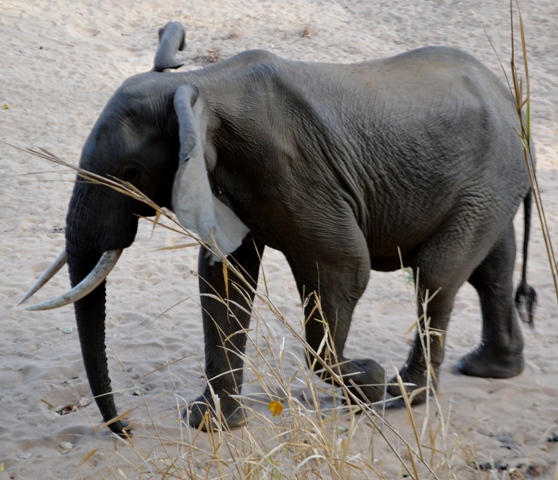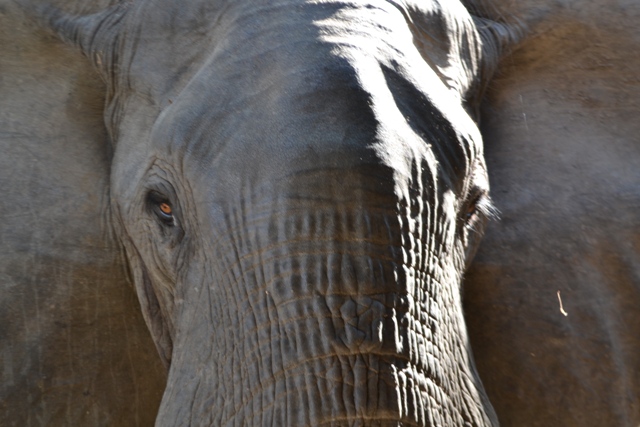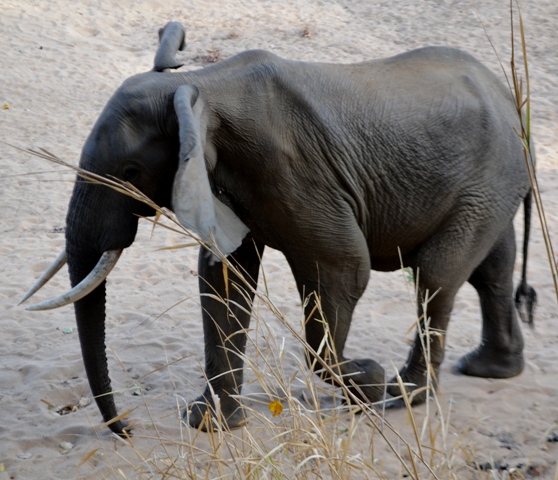
08 Oct Mozambique poachers set sights on Kruger ivory

Conservationists based on Mozambique’s side of the border with the Kruger, where about 40km of fence was dropped in 2002, say elephants have become skittish and aggressive as a result of poaching. Photo: Estacio Valoi
Nine months after the Oxpeckers Center for Investigative Environmental Journalism warned that Mozambican rhino poachers had their sights set on elephants in the Kruger National Park, an elephant bull was purposefully shot for its tusks in the world-famous reserve.
South African National Parks (SANParks) announced on June 16 2014 that the bull’s horns had been hacked off and carried away by suspected poachers from Mozambique. It was the first confirmed elephant poaching incident in the Kruger in well over 10 years.
The incident occurred in the Pafuri region, in the northern part of the reserve. “Rangers patrolling the area noticed footprints of approximately four individuals leading towards Mozambique, leaving the park. Upon further investigations, which involved backtracking, the rangers on patrol came upon the elephant carcass,” said SANParks spokesperson Reynald Thakhuli.
Smuggling routes
Oxpeckers reported in August 2013 that poachers had killed at least 12 big tuskers on the Mozambican side of the border with the Kruger, raising fears that the ivory wars afflicting other parts of Africa were filtering through to the tip of the continent.
Conservationists said elephant poachers were using sophisticated smuggling routes set up to launder rhino horns from the Kruger park via Mozambique to Asian countries.
The global illegal ivory trade has tripled in the past five years, with up to 50 000 elephants killed in 2011, and the proceeds are believed to be funding insurgencies in Central and East Africa, according to the United States department of state.
Poachers have hammered elephant populations in game reserves in northern Mozambique and they are moving south in their quest for big tuskers, said Mozambican conservationist Carlos Lopes Pereira. In the Niassa Reserve on the Mozambican border with Tanzania, at least 2 500 elephants have been killed in the past two years.
“We are losing elephants at the rate of three to four a day in Niassa and all the tuskers are gone. Now the poachers are heading south to smaller reserves in Mozambique and to the Limpopo and Kruger national parks,” said Pereira, a wildlife veterinarian who advises Mozambique’s tourism ministry.
Conservationists based on Mozambique’s side of the border with the Kruger, where about 40km of fence was dropped in 2002, say elephants have become skittish and aggressive as a result of the poaching. At least 12 bulls that had moved into the area are known to have been gunned down and their tusks removed.
Infiltration into the park by poachers, who have killed at least 245 Kruger rhinos this year, has led to growing militarisation along the border. South African security forces are not allowed to pursue poachers across the border, however, despite evidence that armed gangs brazenly use well-worn footpaths and find refuge among communities living in villages dotted along the Mozambican side. Poaching is treated as a misdemeanour in Mozambique and security forces in that country have been implicated in the rhino-horn trade.

One of the last remaining elephants in Niassa reserve in northern Mozambique, where poachers are killing the pachyderms at the rate of three to four a day. Photo: Estacio Valoi
Conservation buffer
On the Mozambican side of the border, the Limpopo National Park forms part of the Great Limpopo Transfrontier Park with the northern section of the Kruger Park. To the south stretch various private ecotourism and hunting outfits operating in what was intended to be a conservation buffer zone along the border down to Komatipoort.
Private concession holders on the Mozambican side, who spoke to Oxpeckers on condition of anonymity, said the Mozambican authorities did not allow them to keep firearms and they had to rely on pepper spray to counter heavily armed poachers. One described how his game scouts tried to encircle rhinos and elephants to chase them back into the Kruger when they crossed the border.
“Sometimes we see bakkies full of poachers following us because they know we have no guns or other recourse. When night falls and the animal is still on the wrong side of the border, we have to leave it and just hope that it is still alive when we get there in the morning,” an operator said.
Communication between anti-poaching forces on either side of the border was limited due to the rough terrain and lack of telecommunication and there was often a spirit of rivalry between officials on the two sides which played into poachers’ hands, they said.
Poachers living in the villages were easy to identify because their huts had changed into mansions in recent months and they drove smart 4X4s, said private operators. But incidents reported to local police and the Frontier Guard were rarely followed up and cases were known to have been quashed after bribes were paid.
In 2013 the SANParks board recommended to Minister of Water and Environmental Affairs Edna Molewa that the boundary fence along the edge of the Kruger be reconstructed because of the “aggressive incursions from Mozambique”. Molewa responded that this would depend on an analysis of the rhino-poaching situation in the park and “a lack of positive results emanating from the creation of a buffer zone” along the border.
